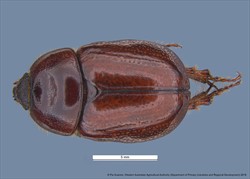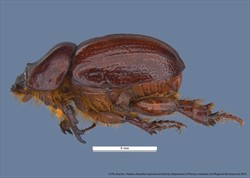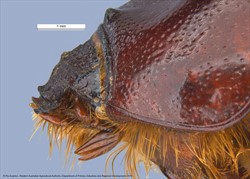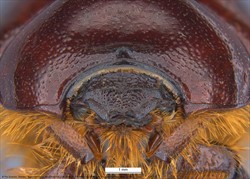Sub family: Dynastinae / Tribe: Pentodontini / Genus: Carneodon
Fact Sheet
Carneodon (Özdikmen, 2009)
Small to medium oblong shaped beetles, body length 10-17mm. Body colouration reddish brown to reddish black. Clypeus narrowing with a truncated margin, rarely emarginate. Apex of clypeus with a pair of tublercles or upturned marginal sinuations. Antennae 10 segmented, with a 3 segmented club. Mentum narrowed towards a rather acute ligula, setose on margins. Frontoclypeal suture present, transverse, forming a ridge and often giving rise to a pair of tubercles. Mandibles toothed, visible beyond clypeus. Ocular canthus glabrous. Pronotum of males with a small frontal tubercle followed by a fovea. Female pronotum evenly convex, or with a slight anteromedian swelling. Scutellum unpunctate. Elytra with sutural striae, or punctate striae. Propygidium with stridulatory ridges present or absent. If present, either dispersed or in pairs of bands. Foretibia tridentate. Metatibia bicarinate. Hind tarsi about as long as hind tibia. Tarsal claws simple.
Carneodon is a commony encountered genus, though little is known about their biology and they are not considered economically important. Larvae are typical of Dynastinae and feed on decaying organic matter in the soil.
Carneodon can be found all across mainland Australia from southern, central and far northern areas. It is absent from Tasmania.
Carne, P.B. 1957. A Systematic Revision of the Australian Dynastinae: (Coleoptera: Scarabaeidae). CSIRO, Melbourne. 284pp.
Endrödi, S. 1985 The Dynstinae of the World. W. Junk. London. 800pp.
Matthews, E.G. 1984 A Guide to the Genera of Beetles of South Australia. Part 3 Polyphaga: Eucinetoidea, Dascilloidea and Scarabaeoidea. Special Educational Bulletin Series (No. 6) South Australian Museum, Adelaide. 60pp.
Weir, T.A., Lawrence J.F., Lemann, C., Gunter N.L. 2019. 33. Scarabaeidae: Dynastinae Macleay, 1919. In: Australian Beetles. Volume 2. Archostemata, Myxophaga, Adephaga, Polyphaga (part) (eds A Ślipiński & JF Lawrence) pp. 516–530. CSIRO, Clayton, Australia.








